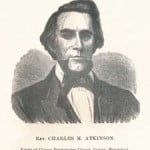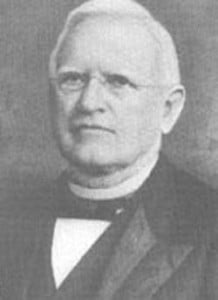An excerpt from The Brazen Serpent, by Joseph Huntington Jones provides our Lord’s Day sermon today. Rev. Jones, as you will remember from yesterday’s post, was a close friend of the Rev. Ashbel Green. Dr. Green entrusted his autobiography to Rev. Jones, that he would see it through to publication after Green’s death.
The Brazen Serpent is, as it turns out, a work addressed to children. As such it provides an excellent example of the quality and caliber of nineteenth-century Presbyterian literature for the juvenile audience. The book was published by the Presbyterian Board of Publication, an agency at that time of the Old School wing of the Presbyterian Church in the U.S.A., being published in 1864, just five years before the reunion of the Old School and New School division. What follows is excerpted from the first chapter of the book. A link to the full work follows at this end of this post. Please consider reading this together with your own children.
THE BRAZEN SERPENT, by Joseph Huntington Jones.
We read in the twenty-first chapter of the book of Numbers, that when the Israelites had been bitten by fiery serpents, Moses made of brass an image of this serpent and put it on a pole, and then whoever looked to this brazen or dead serpent was cured of the bit of the living one. There is something very astonishing here. In the history of diseases and remedies there is nothing like it, and had it not been explained to us by him who appointed it, we should be just as much perplexed to understand it as the Jews are. They cannot imagine why Moses should have been instructed to cure his dying brethren by such a simple thing, which, if it affected them at all, would be presumed to make them worse. The very last object at which a man, mortally wounded by a poisonous serpent, would wish to look, or from which he would expect relief, would be an image of the creature that had bitten him. To explain this wonder, and help us to see the use of it to us as well as to them, I will first recount what Moses did to heal his suffering brethren, and then tell you why God directed him to do it, in this particular way.
Most of my young readers, I presume, are familiar with the remarkable history of the children of Israel in Egypt; of the way in which they were brought out of it; and of their wandering forty years in the wilderness. If those of you who understand geography, will take some good map of this region which has the way the people traveled marked out upon it, you will see that, although they traveled probably more than a thousand miles up and down in this desert country, yet the distance in a straight line is less than three hundred. They were now come to Mount Hor, and had they been permitted to go forward in a direct course, their way would have been short. But to this the king of Edom would not consent, as they would have gone across his territory. This was very provoking, because it compelled them to travel back the very way they had come several days, and through a country that was extremely rough and dreary. It is not at all surprising that the people should have been greatly vexed with this most perverse and disobliging king, who had given them so much needless trouble; but it was not to be helped. He had a right to forbid them, and it was their duty to submit. So they turned about and followed the pillar of cloud and fire; but with such an angry and rebellious temper, that they murmured not against Moses only, but against God. “Wherefore,” said they, “have ye brought us up out of Egypt to die in this wilderness?”
. . . But some of my young readers will say, We do not understand it, after all. We cannot see any resemblance between those poor Hebrews in the wilderness, bitten by the fiery serpents, and ourselves. We have not been bitten, and have no disease in our bodies that should make us afraid, or that gives us any pain. And even if we had, we do not think that we could be cured by looking to Jesus Christ. That is very true, children, in one sense; and your bright eyes, red cheeks, and healthful looks are pleasant tokens that you are well and happy. But this is not all of the truth; you are in health and full of joy and hope now, but it will not be always so. Many of the children who read this little book have buried a beloved parent; some lost their mother, some have no father, and others have neither. In a few years, all of you, their children, will be called to follow them; and what is the cause of this? Why do not persons live for ever here, without becoming old, wrinkled, and gray-haired, and losing their strength, hearing, and eyesight? Why have people, in past ages, with but two exceptions, all gone out of the world by dying? Who do they, soon or late, as certainly die as all the Israelites did who were bitten, before the lifting up of the serpent? Let us go to the apostle Paul for an answer. “By one man sin entered into the world, and death by sin; and so death passed upon all men, for that all have sinned.” Here, then, my dear children, you will see that sin has done the same thing for us, that the fiery serpents did for the Hebrews. It has made us all liable to the death of our bodies, and what is infinitely worse, to the everlasting loss of our souls. This is one point of resemblance.
Another, not less obvious and striking, is the way of escape. As the Israelites could do nothing to save their bodies from death, neither can we do anything for the salvation of our souls. If left to ourselves, in spite of all our works, we shall as certainly lose our souls as the Hebrews would have lost their lives. And in this we notice a second point of resemblance. We are like them in being utterly helpless.
A third is, that as they obtained a cure by looking to the brazen image; so do we receive salvation by looking to Christ. The Saviour does not use the precise words of Moses, and tell us to look to him, but he says, Believe. “As Moses lifted up the serpent in the wilderness, even so must the Son of man be lifted up; that whosoever believeth in him should not perish, but have eternal life.” We see, then, that the great design of God, in adopting this way of curing the bitten Hebrews, was to teach us faith in Christ. Now, a great many people suppose that this is a subject so obscure and hard to be understood, that it is never worth our while to say anything to children about it. But in this little story from the writings of Moses, as explained by the Saviour, it is made so plain that few, if any, children who are able to read, can fail to comprehend it as well as their parents.
And I would now ask my little readers three simple questions that I think they can nearly all answer, and which will show how far the story is understood. And first, What was there in the condition of the Israelites that made it necessary for Moses to lift the serpent on the pole? You tell me, at once, they were in such a dangerous state that multitudes would have died without it. This is correct; you have given the true answer; and this, let me tell you, is the first part of faith in Christ. It is to feel ourselves to be in such a deplorable state, on account of our sins, that we must perish without help.
My next question is, Why did these poor, suffering Israelites look to this brazen image on the pole? Why did they not apply to their physicians, or try to cure themselves? You tell me immediately, because they knew that they would die if they did, and that if they were healed at all, it must be done by turning their eyes to this brazen saviour. True, this is the very answer I wished you to give, and this is the second element of faith in Christ. It is a persuasion that if we are saved at all, our help must come from Christ; that “there is none other name under heaven given among men, whereby we must be saved.” I think, then, you understood this part as well as you did the other.
My third question is, What were their feelings and thoughts when they first lifted their eyes to the image? They felt persuaded, you answer, that if they looked, they would certainly be relieved, no matter how badly they were bitten, or how desperate their bodily condition. Exactly so, children, and this very feeling makes up the remainder of saving faith. It is a conviction, that if we do rely on Christ to save us, he is able, and willing, and ready to do it, the very moment we believe. This is faith, all about it that any of you need know; it is what any of you can know; and, let me add, it is what you all must know, or you will as certainly perish as the Israelites would have died, but for looking to the brazen image.
The Brazen Serpent; or, Faith in Christ Illustrated, by Joseph Huntington Jones. Philadelphia: Presbyterian Board of Publication, 1864. To download this book in PDF or other digital formats, click here.


